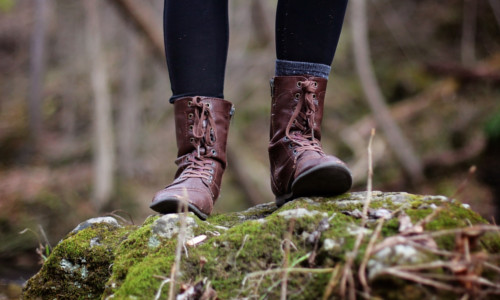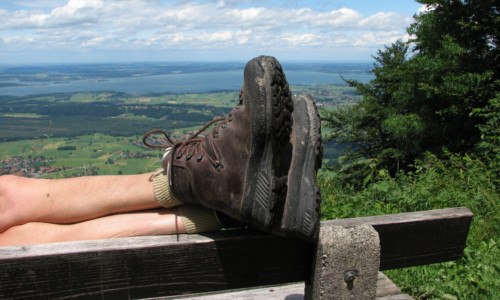Useful Tips for Repairing your Hiking Boots and Shoes Yourself
Author

A keen runner, skier and nuts about cycling. Karl lives in Cumbria, where he loves encouraging his two children to follow in his outdoor lifestyle. Whilst out and about keeping active, Karl keeps a diary and shares it with Outdoor Look.
 Hiking boots and shoes are expensive items which are extensively used on rugged terrains. Due to their use on harsh surfaces, they suffer from wear and tear which curtails their life. Depending on their construction and material, shoes and boots have varied durability. EVA midsole can be expected to last less than 500 miles, while PU ones can be worn for 1,000 to 2,000 miles. However, people who invest in them heavily expect their boots to last longer.
Hiking boots and shoes are expensive items which are extensively used on rugged terrains. Due to their use on harsh surfaces, they suffer from wear and tear which curtails their life. Depending on their construction and material, shoes and boots have varied durability. EVA midsole can be expected to last less than 500 miles, while PU ones can be worn for 1,000 to 2,000 miles. However, people who invest in them heavily expect their boots to last longer.
Expectations and reality related with hiking shoes are quite different, which can lead to disappointment. Feeling gloomy already? Well don’t be, there is still hope for the user who can make some effort and pay attention to their shoes. With some basic repairs and tips, you can prolong the lifespan of your boots and make them last for a long period.
1. Break in your New Hiking Boots
It is not a good idea to wear your boots straightaway on a hike. You need to first warm up to your boots by wearing them at your home. Make sure that you wear the new shoes with the same socks that you will be wearing on your hikes. Once your feet are acclimatized to the boots, you will feel comfortable while hiking and not bump against rocks and pebbles lying on the ground. Walking and running while in full control of the body will prevent accidental damage to your feet and boots.
2. Taking Preventive Care
Whenever you have wetted your shoes in the wild, it is best to lay them upside down to remove the water soaked by them. Also, remove the insoles at night time for proper drying.
Every year when the surface of the boot cracks up, treat it with silicone-based or water-based treatment to enhance its durability. You can also use a leather conditioner to prevent your hiking boots from drying out. Avoid storing your shoes in humid conditions as excess moisture in the air can cause problems like mildew growth.
3. Take Care of the Damage on the Boots
You should know how to identify and treat the signs of damage on your boots. It is very easy for the laces on the boots to rupture after prolonged usage, so always keep a spare pair of laces in your backpack while you are on a hike. If your boots are missing eyelets, send them to a cobbler or back to the company where you bought them from. Boots are hardly ever completely destroyed, but when you see the cushioning on the boots wearing off, it is a sign that you need to buy a new pair.
Important Tip: Never use fire for drying your shoes as the heat can melt or shrink the leather and synthetics.
 4. Clean the Shoes
4. Clean the Shoes
Breathable comfort is essential for a pleasurable hiking experience. Dirt and grime accumulated on shoes can hinder breathability which may make them quite uncomfortable to wear. Use a stiff-bristled brush after each trip to remove the dirt so that your shoes are in prime condition and ready for the elements. You can also make a habit of cleaning your shoes rigorously with a brush and mild detergent every year to keep them looking shiny as new. While cleaning scrub the inside, outside, and let the shoes dry in the shade. Cleaning the insole is a great way to maintain the odorless functionality of your hiking boots.
5. Fixing a Delaminated Boot Sole
In case you have a delaminated sole, you need to address the issue immediately. Remove the debris stuck between the upper and sole. Wipe down both with an alcohol prep pad found in a medical kit. Now, squeeze the upper and sole together and put some weight on it (you can use a rock or a completely filled water bottle). Following this procedure will help you fix the delaminated boot sole.
Author

A keen runner, skier and nuts about cycling. Karl lives in Cumbria, where he loves encouraging his two children to follow in his outdoor lifestyle. Whilst out and about keeping active, Karl keeps a diary and shares it with Outdoor Look.
Categories
- Sport (28)
- Product Reviews (3)
- Team Outdoor Look (7)
- Mike Wild (2)
- Mike Payton (2)
- Suse Hammond-Pears (3)
- Snowboarding (12)
- Latest Offers (105)
- Shop Talk (1)
- Competitions (7)
- Walking (413)
- Lifestyle Fashion (8)
- Travel (86)
- Kit Guides (176)
- Workwear Clothing (6)
- Safety Workwear (4)
- Health/Fitness (289)
- Skiing (91)
- Great Outdoors (1316)
- Cycling (92)
- January 2025
- December 2024
- November 2024
- October 2024
- September 2024
- August 2024
- July 2024
- June 2024
- May 2024
- April 2024
- March 2024
- February 2024
- January 2024
- December 2023
- November 2023
- October 2023
- September 2023
- August 2023
- July 2023
- June 2023
- May 2023
- April 2023
- March 2023
- February 2023
- January 2023
- December 2022
- November 2022
- October 2022
- September 2022
- August 2022
- July 2022
- June 2022
- May 2022
- April 2022
- March 2022
- February 2022
- January 2022
- December 2021
- November 2021
- October 2021
- September 2021
- August 2021
- July 2021
- June 2021
- May 2021
- April 2021
- March 2021
- February 2021
- January 2021
- December 2020
- November 2020
- October 2020
- September 2020
- August 2020
- July 2020
- June 2020
- May 2020
- April 2020
- March 2020
- February 2020
- January 2020
- December 2019
- November 2019
- October 2019
- September 2019
- August 2019
- July 2019
- June 2019
- May 2019
- April 2019
- March 2019
- February 2019
- January 2019
- December 2018
- November 2018
- October 2018
- September 2018
- August 2018
- July 2018
- June 2018
- May 2018
- April 2018
- March 2018
- February 2018
- January 2018
- December 2017
- November 2017
- October 2017
- September 2017
- August 2017
- July 2017
- June 2017
- May 2017
- April 2017
- March 2017
- February 2017
- January 2017
- December 2016
- November 2016
- October 2016
- September 2016
- August 2016
- July 2016
- June 2016
- May 2016
- April 2016
- March 2016
- February 2016
- January 2016
- December 2015
- November 2015
- October 2015
- September 2015
- August 2015
- July 2015
- June 2015
- May 2015
- April 2015
- March 2015
- February 2015
- January 2015
- December 2014
- November 2014
- October 2014
- September 2014
- August 2014
- July 2014
- June 2014
- May 2014
- April 2014
- March 2014
- February 2014
- January 2014
- December 2013
- November 2013
- October 2013
- September 2013
- August 2013
- July 2013
- June 2013
- May 2013
- April 2013
- March 2013
- February 2013
- January 2013
- December 2012
- November 2012
- October 2012
- September 2012
- August 2012
- July 2012
- June 2012
- May 2012
- April 2012
- March 2012
- February 2012
- January 2012
- December 2011
- November 2011
- October 2011
- September 2011
- August 2011
- May 2010
- April 2010
- March 2010
- February 2010
- January 2010
- November 2009
- October 2009
- September 2009
Submit a Comment